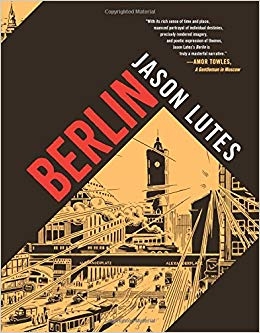Referencing the Weimar Republic has become something of a cliché recently, and so it is important to highlight that Jason Lutes started work on Berlin, his impressive graphic novel about life in the city between the wars, over 20 years ago. Serialised as 22 individual comics, we now have the collection in a handsome brick of a book. This monumental effort is rewarded by arriving when a warning about the far-right could not be timelier.
The story begins with a nod to cinema when, as in Walter Ruttmann’s Berlin: Symphony of a Great City (1927), a train approaches the outskirts. Marthe Müller, a young woman artist keen to try her luck in the metropolis, meets the journalist Kurt Severing. They fall in love, but the story is soon complicated by the political heat of the day. Marthe attends art school and learns about Neue Sachlichkeit (the New Objectivity) but struggles to find meaning in her own drawings in an age of rapidly evolving media, specifically radio and the movies. Kurt is the hardboiled hack who chronicles the steady decline of Germany into barbarism. Real-life figures pop up, such as Kurt’s boss, the editor Carl von Ossietzky, soon to die in Nazi custody despite his being awarded the Nobel Peace Prize.
Marthe befriends the androgynous Anna and finds herself introduced to a secret Berlin of underground clubs where she jives to jazz. One of the many entertaining subplots features an Afro-American band in exile struggling to make sense of the troubled city. These night scenes are atmospherically rendered and recall the shiny surfaces of reflected neon seen in films such as Joe May’s Asphalt (1929). The beams of streetlighting and ubiquitous advertisements on the Litfaßsäule columns help conjure the glamorous appeal of glittering nocturnal escapades.
Given Marthe’s vocation, it is appropriate that there should be numerous references to artists of the time. More bolts of light burst over a scene in Alexanderplatz recalling Lyonel Feininger’s woodcut Cathedral (1919); war cripples on the streets resembling those painted by Otto Dix typify what we hear labelled as ‘the sourness of neglect’. We also encounter swinish industrialists like those depicted by George Grosz, and other dodgy characters similar to the freaks hanging around The Rooftop Studio (c. 1922) by Rudolf Schlichter. In a bar Marthe meets a top-hatted beauty taken directly from She Represents (Carnival Scene) (c. 1928) by Jeanne Mammen. She exemplifies the new women in the city – die Neue Frau – empowered by the mass demasculinisation of the First World War. Lutes documents the success these women have in their new roles and delights in drawing their fashions and their bubikopf – the groovy geometric hairstyles of the day.
Lutes is attentive to period detail as culled from photographs of pre-Nazi Berlin, as seen in his evocative image of a shiny Potsdamer Platz before it was trashed. In contrast he shows struggle in the desperate poverty of the Mietskaserne, the tenement slums and rental barracks found in Communist districts like Wedding. We are not shown a swastika until page 506, as if the Nazi threat was in a sense unseen, naively dismissed, by the privileged before Hitler’s ascension to power. Lutes outlines too how life was incrementally made more difficult for Jews, homosexuals and people of colour, and, with particular contemporary relevance, for Anna, the trans character.
Lutes is deft at handling a complex story. Comic books can play with the limits of language, and he is eloquent in his use of silent speech bubbles that scream with frustration. He pinches Wim Wenders’s idea from Wings of Desire (1987) that we can hear a character’s thoughts as they ride the S-Bahn. The influence of Art Spiegelman and Chris Ware is acknowledged, but Lutes’s work has its own punch. Berlin catches the descent into disaster without falling into overt toadying before its illustrious literary predecessors. And Lutes captures the calamity of losing a society to fascism.
Berlin by Jason Lutes, Drawn & Quarterly, $49.95/£35 (hardcover)
From the January & February 2019 issue of ArtReview
